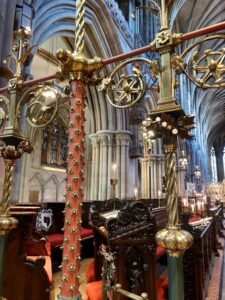I hadn’t been to a Prom since 2019 and was determined to fit one in from this season, choosing Beethoven’s Missa Solemnis performed by the Orchestre Révolutionnaire et Romantique conducted by John Eliot Gardiner, on the Wednesday of the final week. There was of course no Last Night of the Proms in 2022, or any further concerts after this one.
I had never heard the Mass in performance before although I have sung it. This performance was well played and sung by the smallish choir, (the lower pitch making the vocal writing less strenuous) though I missed the magical sound you can achieve when many people sing really quietly. Perhaps this was why I felt that overall it didn’t have as much of a sense of awe as I’d have wished.
One thing surprised me: JEG places great emphasis on the period sound of his orchestra and his desire to get behind twentieth-century performance practice to rediscover earlier works afresh. But the Mass was sung with Italian pronunciation, not the German Latin which is now common in performances of this work (including the one I sang in a few years ago).
Usually the soloists are in front of the orchestra, holding their scores. But here the soloists (a well-matched group) were placed behind the orchestra and off-centre, in front of the men in the choir. They were equipped with music stands. which made possible something that transformed the performance for me: with her hands free, the soprano Lucy Crowe was able to move them expressively. A reminder that you have to bring your whole body to this work, otherwise it is unsingable.
Unfortunately my view of all this was spoilt by someone between me and the performers who kept shuffling some A4 sheets of paper on his knee throughout. If they had a compulsion to fidget, perhaps they should have been given something smaller and darker, which would have been less distracting, or been taken to the Relaxed Prom earlier in the day? If they didn’t, there really isn’t much excuse.
Another unsatisfactory matter was the printed programme. I have found these useful in the past, particularly when new music is being performed. But there were scanty column inches on the Mass, which told me little I didn’t already know. Comparing it to the programme for my performance of Mahler 8 in 2018, which devoted about twice as much space to the work being performed. I felt rather short-changed and will think twice before buying a programme at the Proms in future.
Some reviews:



